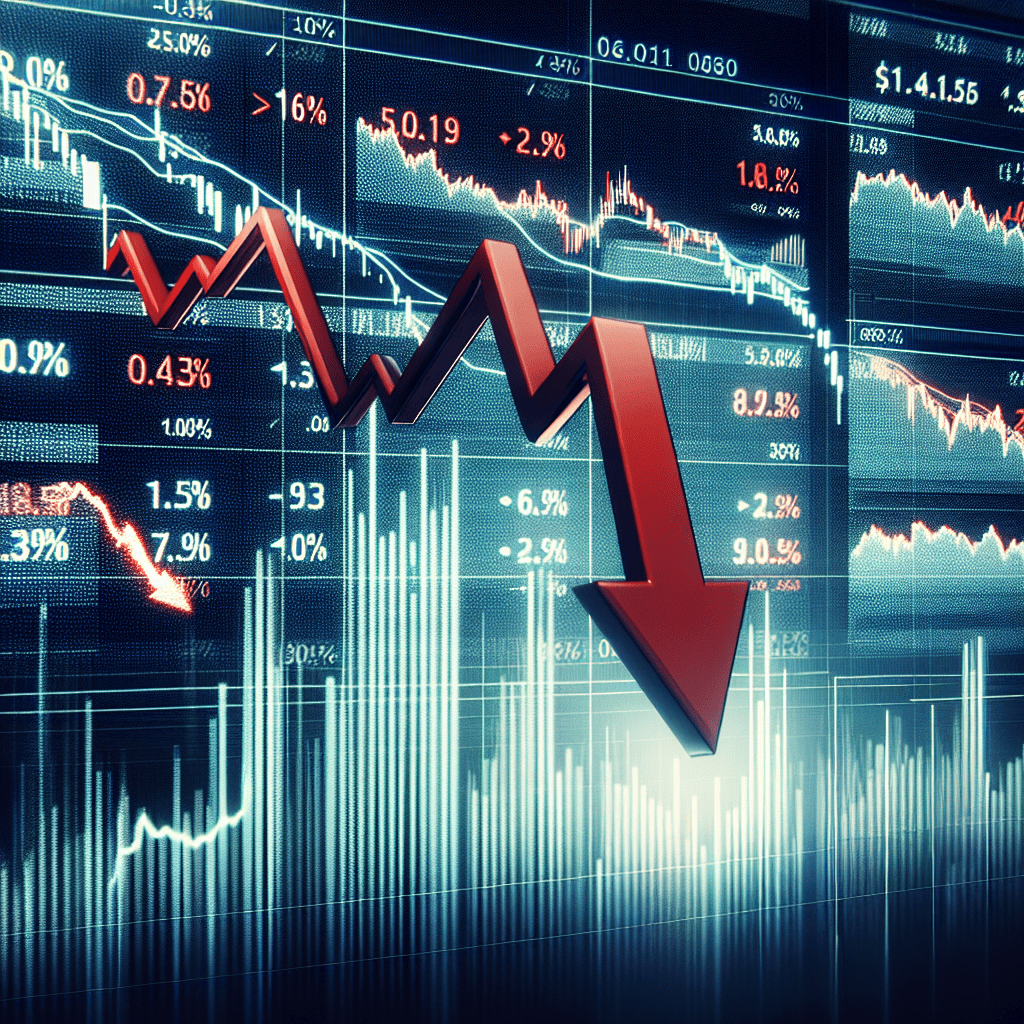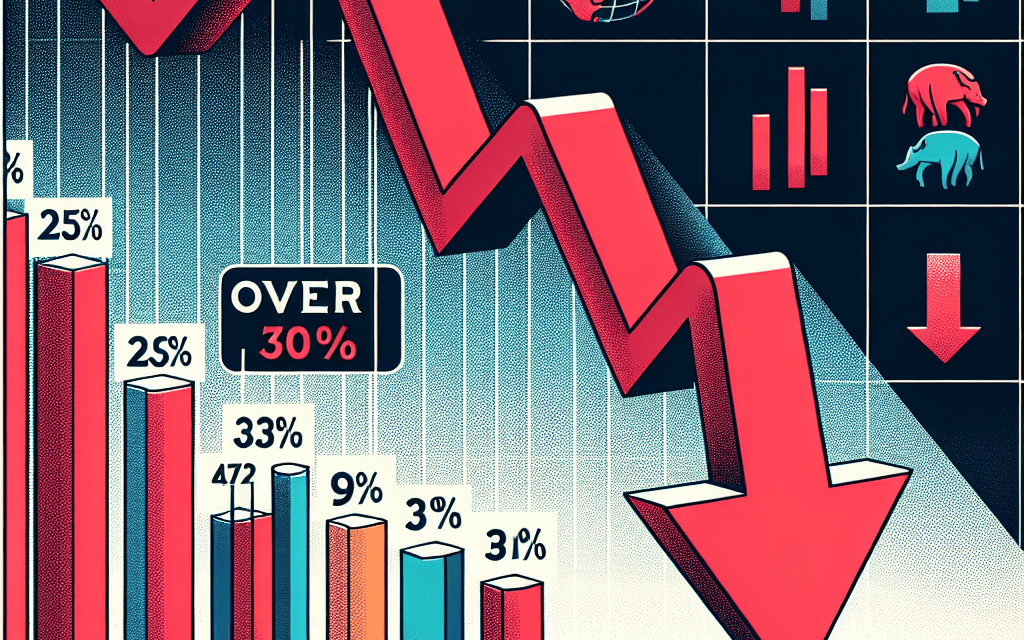“Steer Clear: 7 Stocks on the Brink of a 30% Dive”
Introduction
In the ever-volatile world of stock markets, identifying potential pitfalls is as crucial as spotting opportunities for growth. As investors navigate the complexities of financial markets, certain stocks emerge as high-risk contenders, poised for significant declines. This analysis highlights seven such stocks that are projected to plummet by over 30%, based on a confluence of factors including deteriorating financial health, adverse market conditions, and unfavorable industry trends. By examining these stocks, investors can better strategize to safeguard their portfolios against substantial losses and make informed decisions in an unpredictable economic landscape.
Understanding Market Volatility: Why These 7 Stocks Are Risky
In the ever-evolving landscape of the stock market, understanding market volatility is crucial for investors aiming to safeguard their portfolios. Market volatility, characterized by rapid and significant price movements, can be both an opportunity and a risk. While some investors thrive on the potential for high returns, others may find themselves on the losing end if they fail to navigate these turbulent waters carefully. In this context, identifying stocks that are poised for a downturn is essential. This article delves into seven stocks that are projected to plummet over 30%, highlighting the reasons behind their anticipated decline and the broader implications for investors.
To begin with, it is important to recognize that market volatility often stems from a combination of macroeconomic factors, industry-specific challenges, and company-specific issues. For instance, economic indicators such as interest rates, inflation, and geopolitical tensions can significantly impact investor sentiment and, consequently, stock prices. In the case of the seven stocks in question, a confluence of these factors has created a precarious situation. For example, companies operating in industries heavily reliant on consumer spending may face headwinds due to rising inflation, which erodes purchasing power and dampens demand. As a result, stocks in sectors such as retail and consumer discretionary are particularly vulnerable.
Moreover, industry-specific challenges can exacerbate the risks associated with certain stocks. Technological disruption, regulatory changes, and shifts in consumer preferences can all contribute to a company’s decline. In the technology sector, for instance, companies that fail to innovate or adapt to changing market dynamics may find themselves losing ground to more agile competitors. Similarly, in the energy sector, the transition towards renewable energy sources poses a significant threat to traditional fossil fuel companies. These industry-specific challenges underscore the importance of conducting thorough research and analysis before making investment decisions.
In addition to macroeconomic and industry-specific factors, company-specific issues play a pivotal role in determining a stock’s trajectory. Poor management decisions, declining financial performance, and legal troubles can all contribute to a company’s downfall. For example, a company with a history of mismanagement may struggle to execute its strategic initiatives effectively, leading to a loss of investor confidence. Similarly, a company facing mounting legal challenges may incur significant financial liabilities, further eroding its stock value. Investors must remain vigilant and consider these company-specific risks when evaluating potential investments.
Furthermore, it is essential to recognize that market sentiment can amplify the impact of these factors. In times of uncertainty, investors may react emotionally, leading to exaggerated price movements. This phenomenon, often referred to as a “market overreaction,” can result in stocks being oversold, creating opportunities for astute investors to capitalize on undervalued assets. However, it can also lead to significant losses for those who fail to anticipate the market’s response to negative news.
In conclusion, understanding market volatility and the factors contributing to the decline of specific stocks is vital for investors seeking to protect their portfolios. By examining macroeconomic trends, industry-specific challenges, and company-specific issues, investors can make informed decisions and avoid stocks that are likely to plummet. While the allure of high returns may tempt some to take on greater risks, a cautious and well-researched approach is essential in navigating the complexities of the stock market. As such, investors should remain vigilant and prioritize due diligence to mitigate potential losses and achieve long-term financial success.
Analyzing Financial Indicators: Red Flags in These 7 Stocks
In the ever-evolving landscape of the stock market, investors are constantly on the lookout for opportunities that promise substantial returns. However, the flip side of this pursuit involves identifying potential pitfalls that could lead to significant financial losses. In this context, analyzing financial indicators becomes crucial, as it helps investors discern which stocks might be on the verge of a downturn. This article delves into seven stocks that are currently exhibiting red flags, suggesting they could plummet by over 30% in the near future.
To begin with, one of the primary indicators of a stock’s potential decline is its price-to-earnings (P/E) ratio. A disproportionately high P/E ratio often signals that a stock is overvalued, which can lead to a market correction. For instance, Company A, a tech firm that has enjoyed rapid growth, now finds itself with a P/E ratio significantly higher than the industry average. This discrepancy raises concerns about whether its current valuation is sustainable, especially in a market where investor sentiment can shift rapidly.
Moreover, another critical factor to consider is the company’s debt levels. Excessive debt can be a harbinger of financial instability, particularly if the company struggles to generate sufficient revenue to meet its obligations. Company B, a retail giant, has recently reported a surge in its debt-to-equity ratio, which has alarmed analysts. This increase in debt, coupled with declining sales figures, suggests that the company may face challenges in maintaining its financial health, potentially leading to a sharp decline in its stock price.
In addition to these financial metrics, it is essential to examine the broader economic environment in which these companies operate. For example, Company C, an energy firm, is heavily reliant on oil prices, which have been volatile due to geopolitical tensions and shifts in global demand. As oil prices fluctuate, so too does the company’s revenue stream, making it vulnerable to market downturns. This dependency on external factors adds an element of risk that investors should not overlook.
Furthermore, changes in consumer behavior can also impact a company’s prospects. Company D, a traditional media company, has been slow to adapt to the digital age, resulting in a steady decline in its audience base. As more consumers turn to digital platforms for content consumption, the company’s failure to innovate and capture this market segment could lead to a significant drop in its stock value.
Additionally, regulatory challenges can pose substantial risks to a company’s future performance. Company E, a pharmaceutical firm, is currently embroiled in legal battles over patent infringements. These legal issues not only drain financial resources but also create uncertainty about the company’s ability to bring new products to market, thereby affecting investor confidence.
Moreover, insider trading activity can serve as a warning sign for potential stock declines. Company F, a financial services provider, has recently seen a spate of insider selling, which often indicates that those closest to the company anticipate a downturn. This trend, combined with stagnant growth in its core business areas, suggests that the stock may be poised for a significant drop.
Lastly, it is crucial to consider the competitive landscape. Company G, a consumer electronics manufacturer, faces intense competition from both established players and new entrants. This heightened competition has eroded its market share and profit margins, raising concerns about its ability to sustain its current valuation.
In conclusion, while the stock market offers numerous opportunities for growth, it is equally important to remain vigilant about potential risks. By closely analyzing financial indicators and considering external factors, investors can better identify stocks that may be on the brink of a substantial decline. As such, exercising caution and conducting thorough due diligence are essential steps in safeguarding one’s investment portfolio.
Expert Opinions: What Analysts Say About These 7 Stocks
In the ever-evolving landscape of the stock market, investors are constantly seeking guidance to make informed decisions. As market dynamics shift, certain stocks that once seemed promising may now be poised for significant declines. Analysts have identified seven such stocks that are projected to plummet by over 30%, urging investors to exercise caution. Understanding the rationale behind these predictions can provide valuable insights into the complexities of market behavior.
To begin with, Company A, a once-dominant player in the tech industry, is facing mounting challenges. Analysts point to its declining market share and increasing competition from more agile startups. Furthermore, recent earnings reports have failed to meet expectations, raising concerns about its ability to innovate and maintain profitability. Consequently, experts predict a substantial drop in its stock value, advising investors to reconsider their positions.
Similarly, Company B, a major retailer, is grappling with the repercussions of shifting consumer preferences. The rise of e-commerce has significantly impacted its brick-and-mortar sales, and despite efforts to bolster its online presence, the company has struggled to keep pace with industry leaders. Analysts highlight its mounting debt and shrinking profit margins as red flags, suggesting that a downturn in its stock price is imminent.
In the energy sector, Company C is another stock under scrutiny. While it once thrived on traditional energy sources, the global shift towards renewable energy has left it vulnerable. Analysts emphasize the company’s slow adaptation to this transition, coupled with regulatory pressures and environmental concerns. As a result, they foresee a steep decline in its stock value, urging investors to explore more sustainable alternatives.
Moving on to the financial sector, Company D, a prominent bank, is facing headwinds due to economic uncertainties. Analysts cite rising interest rates and geopolitical tensions as factors that could adversely affect its profitability. Moreover, recent regulatory changes have added to its operational challenges. Given these circumstances, experts predict a significant drop in its stock price, advising investors to exercise caution.
In the healthcare industry, Company E is experiencing setbacks that have caught the attention of analysts. Despite its strong pipeline of products, regulatory hurdles and increased competition have hindered its growth prospects. Additionally, recent controversies surrounding its pricing strategies have raised ethical concerns. Consequently, experts anticipate a sharp decline in its stock value, recommending that investors reassess their portfolios.
Turning to the telecommunications sector, Company F is facing a turbulent period. Analysts point to its outdated infrastructure and inability to keep up with technological advancements as major drawbacks. Furthermore, its heavy reliance on traditional revenue streams has left it vulnerable to market disruptions. As a result, experts predict a substantial drop in its stock price, advising investors to explore more forward-looking opportunities.
Lastly, Company G, a well-known player in the automotive industry, is grappling with the challenges of transitioning to electric vehicles. Analysts highlight its slow progress in this area, coupled with supply chain disruptions and increased competition from innovative startups. These factors have led experts to forecast a significant decline in its stock value, urging investors to consider more dynamic alternatives.
In conclusion, while the stock market offers numerous opportunities, it is crucial for investors to remain vigilant and informed. The insights provided by analysts regarding these seven stocks serve as a reminder of the importance of thorough research and strategic decision-making. By understanding the underlying factors contributing to these potential declines, investors can navigate the market with greater confidence and prudence.
Historical Performance: Patterns That Predict a 30% Drop

In the world of investing, understanding historical performance patterns is crucial for predicting potential downturns in stock prices. Investors often rely on these patterns to make informed decisions, aiming to avoid significant losses. When it comes to stocks that are set to plummet over 30%, certain historical indicators can serve as red flags. By examining these patterns, investors can better navigate the volatile landscape of the stock market.
One of the most telling indicators of a potential 30% drop is a consistent decline in a company’s earnings over several quarters. When a company repeatedly fails to meet earnings expectations, it often signals underlying issues that could lead to a significant drop in stock value. For instance, if a company has reported declining earnings for three consecutive quarters, it may be a precursor to a more substantial downturn. This pattern suggests that the company is struggling to maintain profitability, which can erode investor confidence and lead to a sell-off.
In addition to earnings declines, another pattern to watch for is a high debt-to-equity ratio. Companies with excessive debt are more vulnerable to economic downturns and interest rate hikes. When a company is heavily leveraged, even a slight increase in interest rates can significantly impact its bottom line, leading to a sharp decline in stock prices. Historical data shows that companies with high debt levels often experience more pronounced stock price drops during economic contractions, making them risky investments.
Moreover, a sudden and unexplained drop in stock price can also be a harbinger of a more significant decline. While market fluctuations are normal, a sharp decrease without any apparent reason may indicate that insiders are aware of negative information not yet available to the public. This pattern, often referred to as a “bearish divergence,” can be a warning sign for investors to reconsider their positions in the stock.
Furthermore, companies facing legal challenges or regulatory scrutiny often see their stock prices plummet. Historical performance data reveals that stocks of companies embroiled in legal battles or under investigation by regulatory bodies tend to suffer significant declines. The uncertainty surrounding the outcome of such issues can lead to a loss of investor confidence, resulting in a substantial drop in stock value.
Another pattern that can predict a 30% drop is a decline in industry performance. When an entire industry faces challenges, individual companies within that sector are likely to experience stock price declines. For example, if the technology sector is undergoing a downturn due to decreased consumer demand or increased competition, companies within that sector may see their stock prices fall in tandem. Investors should be wary of stocks in industries that are experiencing widespread difficulties.
Additionally, a company’s inability to innovate or adapt to changing market conditions can also signal a potential decline. Companies that fail to keep up with technological advancements or shifts in consumer preferences often see their market share erode, leading to a decrease in stock value. Historical performance patterns show that companies unable to adapt to market changes are more likely to experience significant stock price drops.
In conclusion, by recognizing these historical performance patterns, investors can better predict which stocks are set to plummet over 30%. Declining earnings, high debt levels, unexplained stock price drops, legal challenges, industry downturns, and a lack of innovation are all indicators that can help investors avoid significant losses. Understanding these patterns allows investors to make more informed decisions, ultimately leading to more successful investment strategies.
Sector-Specific Risks: Industries to Watch Out For
In the ever-evolving landscape of the stock market, investors are constantly on the lookout for opportunities that promise growth and stability. However, just as crucial as identifying potential winners is the ability to recognize stocks that may be on the brink of significant decline. In this context, sector-specific risks play a pivotal role in determining the trajectory of certain stocks. As we delve into the industries to watch out for, it becomes evident that some stocks are poised to plummet by over 30%, making it imperative for investors to exercise caution.
To begin with, the technology sector, often lauded for its rapid innovation and growth potential, is not immune to downturns. Companies that have over-leveraged themselves in pursuit of expansion may find themselves vulnerable to market corrections. For instance, tech firms heavily reliant on consumer electronics face the dual threat of supply chain disruptions and fluctuating consumer demand. As global economic uncertainties persist, these companies may struggle to maintain their profit margins, leading to a potential decline in stock value.
Transitioning to the energy sector, the shift towards renewable energy sources has been a double-edged sword. While it presents opportunities for growth, traditional oil and gas companies are grappling with the challenges of adapting to a changing energy landscape. Regulatory pressures and the increasing adoption of sustainable practices have put a strain on these companies. Consequently, those unable to pivot effectively may experience a significant drop in their stock prices as investors seek more sustainable alternatives.
In the realm of retail, the rise of e-commerce has revolutionized consumer behavior, leaving brick-and-mortar stores in a precarious position. Retailers that have failed to establish a robust online presence are particularly at risk. The ongoing trend of digital transformation means that companies unable to compete in the online marketplace may see their revenues dwindle. This shift in consumer preferences, coupled with rising operational costs, could result in a substantial decrease in stock value for traditional retail giants.
Moreover, the healthcare sector, while generally considered a safe haven, is not without its pitfalls. Pharmaceutical companies facing patent expirations and increased competition from generic drug manufacturers are particularly vulnerable. The loss of exclusivity on key products can lead to a sharp decline in revenue, subsequently impacting stock performance. Additionally, regulatory challenges and the high cost of drug development further exacerbate the risks faced by these companies.
Furthermore, the financial sector is navigating a complex landscape marked by fluctuating interest rates and regulatory changes. Banks and financial institutions heavily exposed to volatile markets may find themselves at risk. The potential for increased loan defaults and reduced profitability in a challenging economic environment could lead to a significant drop in stock prices for these entities.
Lastly, the automotive industry is undergoing a transformative phase with the advent of electric vehicles. Traditional automakers that have been slow to embrace this shift may find themselves lagging behind. As consumer preferences evolve and environmental regulations tighten, companies that fail to innovate may experience a decline in market share, resulting in a potential plummet in stock value.
In conclusion, while the stock market offers numerous opportunities, it is essential for investors to remain vigilant and informed about sector-specific risks. By identifying industries and stocks that are susceptible to significant declines, investors can make more informed decisions and mitigate potential losses. As the market continues to evolve, staying abreast of these trends will be crucial in navigating the complexities of investing.
Investor Sentiment: How Market Perception Affects These Stocks
Investor sentiment plays a crucial role in the stock market, often dictating the rise and fall of stock prices. When investors collectively perceive a company in a negative light, it can lead to a significant decline in its stock value. This phenomenon is particularly evident in the case of certain stocks that are currently poised to plummet by over 30%. Understanding the factors that contribute to such negative sentiment can provide valuable insights for investors looking to navigate the volatile market landscape.
To begin with, one of the primary drivers of negative investor sentiment is poor financial performance. Companies that consistently fail to meet earnings expectations or exhibit declining revenue trends often find themselves in the crosshairs of skeptical investors. For instance, a company that has repeatedly missed its quarterly earnings targets may face a loss of confidence from investors, leading to a sell-off of its shares. This, in turn, can create a downward spiral, as the declining stock price further erodes investor confidence.
In addition to financial performance, management decisions also play a pivotal role in shaping investor sentiment. Companies that are perceived to have poor leadership or lack a clear strategic direction often struggle to maintain investor trust. For example, a company that frequently changes its CEO or fails to articulate a coherent business strategy may be viewed as unstable, prompting investors to divest their holdings. This perception of instability can be exacerbated by negative news coverage or analyst downgrades, further contributing to the stock’s decline.
Moreover, external factors such as regulatory challenges and market competition can also influence investor sentiment. Companies operating in highly regulated industries may face increased scrutiny, leading to potential legal or compliance issues that can negatively impact their stock prices. Similarly, companies that are unable to effectively compete in their respective markets may lose market share, resulting in diminished investor confidence. In such cases, the perception of a company’s inability to navigate these external challenges can lead to a significant drop in its stock value.
Furthermore, macroeconomic conditions can also affect investor sentiment towards certain stocks. In times of economic uncertainty or recession, investors tend to gravitate towards safer, more stable investments, often at the expense of riskier stocks. Companies that are heavily reliant on consumer spending or are highly leveraged may be particularly vulnerable during such periods, as investors become more risk-averse. This shift in investor preference can lead to a sharp decline in the stock prices of companies perceived as high-risk.
In conclusion, investor sentiment is a powerful force that can significantly impact stock prices. Companies that are perceived negatively due to poor financial performance, questionable management decisions, regulatory challenges, or unfavorable macroeconomic conditions are at risk of experiencing substantial declines in their stock values. For investors, understanding these factors and how they influence market perception is essential for making informed investment decisions. By staying attuned to the underlying drivers of investor sentiment, investors can better anticipate potential pitfalls and avoid stocks that are set to plummet by over 30%. As the market continues to evolve, maintaining a keen awareness of investor sentiment will remain a critical component of successful investing.
Diversification Strategies: Protecting Your Portfolio from High-Risk Stocks
In the ever-evolving landscape of the stock market, investors are constantly seeking strategies to safeguard their portfolios from potential downturns. One effective approach is diversification, which involves spreading investments across various asset classes to mitigate risk. However, even with a diversified portfolio, it is crucial to remain vigilant about high-risk stocks that could significantly impact overall returns. In this context, identifying stocks that are poised to plummet by over 30% can be instrumental in protecting your investments.
To begin with, understanding the factors that contribute to a stock’s potential decline is essential. Economic indicators, industry trends, and company-specific issues often play a pivotal role in determining a stock’s trajectory. For instance, a company operating in a declining industry may face headwinds that could lead to a substantial drop in its stock price. Similarly, firms with weak financials or those embroiled in legal troubles are more susceptible to sharp declines. By closely monitoring these factors, investors can make informed decisions about which stocks to avoid.
Moreover, it is important to consider the broader economic environment when evaluating high-risk stocks. In times of economic uncertainty, such as during a recession or geopolitical tensions, certain sectors may be more vulnerable than others. For example, cyclical industries like travel and leisure often experience significant downturns during economic slowdowns. Consequently, stocks within these sectors may be at a higher risk of plummeting, making them candidates for exclusion from a well-diversified portfolio.
In addition to economic and industry-specific factors, company performance metrics are critical in assessing the risk associated with a particular stock. Key indicators such as declining revenue, shrinking profit margins, and increasing debt levels can signal potential trouble ahead. Companies that consistently miss earnings expectations or provide weak forward guidance may also be on the brink of a significant stock price decline. Therefore, conducting thorough due diligence on a company’s financial health is imperative for investors aiming to avoid high-risk stocks.
Furthermore, it is worth noting that market sentiment can greatly influence stock prices. Stocks that have been subject to excessive speculation or hype may be overvalued, making them vulnerable to sharp corrections. In such cases, a sudden shift in investor sentiment can trigger a rapid sell-off, leading to substantial losses. By being cautious of stocks with inflated valuations or those heavily reliant on market sentiment, investors can better protect their portfolios from potential pitfalls.
While identifying high-risk stocks is crucial, it is equally important to have a proactive strategy in place to manage these risks. Regularly reviewing and rebalancing your portfolio can help ensure that it remains aligned with your investment goals and risk tolerance. Additionally, employing stop-loss orders or setting predetermined exit points can provide a safety net, allowing you to limit potential losses.
In conclusion, diversification remains a cornerstone of effective portfolio management, but it is not a foolproof shield against high-risk stocks. By staying informed about economic trends, industry dynamics, and company performance, investors can make prudent decisions to avoid stocks that are likely to plummet by over 30%. Through careful analysis and proactive risk management, it is possible to navigate the complexities of the stock market and safeguard your investments against significant downturns.
Q&A
1. **Question:** What is the primary reason for avoiding stocks that are set to plummet over 30%?
– **Answer:** The primary reason is to prevent significant financial losses in your investment portfolio.
2. **Question:** What are common indicators that a stock might plummet over 30%?
– **Answer:** Common indicators include poor financial performance, negative market sentiment, declining industry trends, and adverse regulatory changes.
3. **Question:** How can investors identify stocks that are likely to decline significantly?
– **Answer:** Investors can identify such stocks by analyzing financial statements, monitoring news and analyst reports, and using technical analysis to spot negative trends.
4. **Question:** What role does market sentiment play in the potential decline of a stock?
– **Answer:** Market sentiment can greatly influence a stock’s price, as negative sentiment can lead to increased selling pressure and a subsequent decline in stock value.
5. **Question:** Why is it important to consider industry trends when evaluating stock performance?
– **Answer:** Industry trends can impact a company’s growth prospects and profitability, making it crucial to assess whether a stock is aligned with positive or negative industry movements.
6. **Question:** How can regulatory changes affect a stock’s performance?
– **Answer:** Regulatory changes can impose new costs, alter competitive dynamics, or restrict business operations, potentially leading to a decline in stock value.
7. **Question:** What strategies can investors use to protect their portfolios from stocks set to plummet?
– **Answer:** Investors can diversify their portfolios, set stop-loss orders, and regularly review and adjust their holdings based on updated information and analysis.
Conclusion
In conclusion, investors should exercise caution and consider avoiding the seven stocks identified as having a high likelihood of plummeting over 30%. These stocks may be facing significant challenges such as deteriorating financial performance, unfavorable market conditions, or strategic missteps that could lead to substantial declines in their value. By steering clear of these potentially high-risk investments, investors can better protect their portfolios from significant losses and focus on opportunities with more stable or positive growth prospects.





